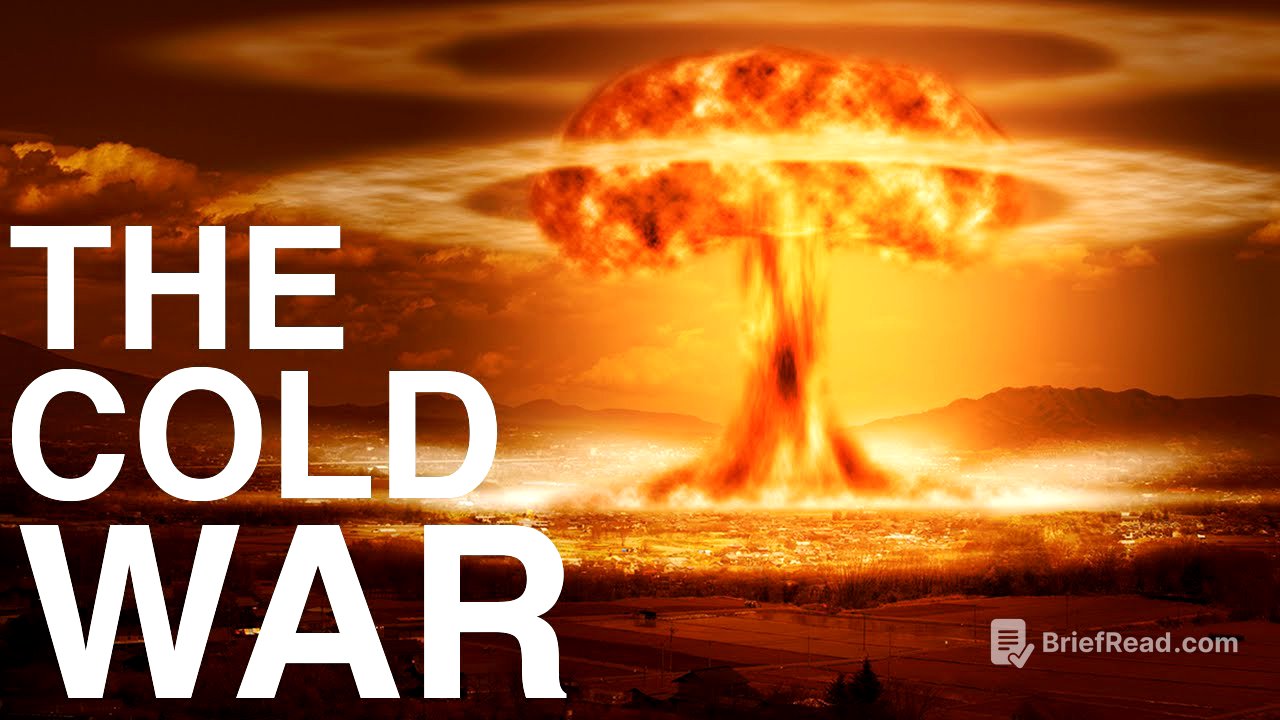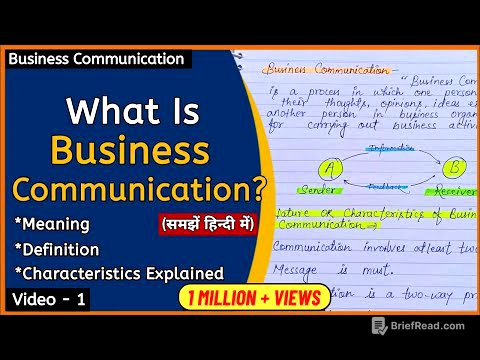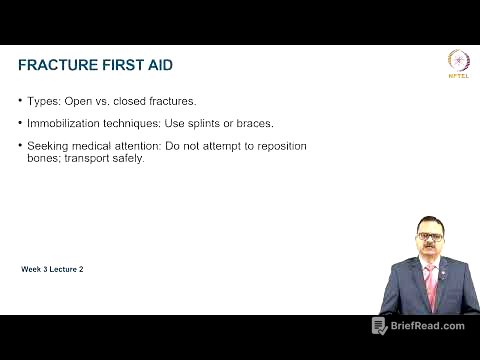TLDR;
This video provides a comprehensive overview of the Cold War, from its origins in the aftermath of World War II to its conclusion with the dissolution of the Soviet Union in 1991. It examines the ideological battle between communism and capitalism, the key figures and events that shaped the conflict, and the global impact of the struggle for power and influence between the United States and the Soviet Union.
- Origins and Ideological Roots of the Cold War
- Key Events and Turning Points
- The End of the Cold War
Introduction: The Cold War Defined [0:00]
The Cold War, emerging after World War II, was an ideological clash between the United States and the Soviet Union, representing capitalism and communism, respectively. This conflict was characterized by proxy wars, nuclear arms race, propaganda, espionage, and a technological rivalry, notably the space race. Key events and figures, such as the Berlin Wall, the CIA, and leaders from Stalin to Reagan, defined this era.
The Rise of Communism and Capitalism [1:54]
In the 19th century, Karl Marx's theories emerged, criticizing the economic inequality of the Industrial Revolution and advocating for communism, a system of common ownership. Communism took root in Russia, leading to the Bolshevik Revolution in 1917 under Vladimir Lenin, who established a one-party state. Meanwhile, capitalism in the West faced challenges, including market failures and the aftermath of World War I. American President Woodrow Wilson proposed reforms promoting self-determination and economic liberalization, but his vision was undermined by the failure of the League of Nations and the rise of fascist regimes.
World War II and the Seeds of Distrust [5:59]
Despite being allies during World War II, the Soviet Union, the United States, and Great Britain had differing wartime experiences that laid the groundwork for future conflict. The USSR endured immense devastation and casualties, leading Stalin to distrust the West's delayed opening of a second front. The United States, experiencing minimal damage and economic growth, sought to establish a post-war order based on collective security and economic stability. However, disagreements over the future of Eastern Europe, particularly Poland, and the division of Germany at the Potsdam Conference, deepened the divide between the Allies.
The Dawn of the Nuclear Age [10:08]
The United States' successful testing of the atomic bomb during the Potsdam Conference gave Truman a strategic advantage over Stalin. The decision to bomb Hiroshima and Nagasaki led to Japan's surrender, preventing Soviet expansion in Asia. Post-war cooperation quickly deteriorated as Stalin sought to secure Soviet borders, leading to the Truman Doctrine and the policy of containment, marking the beginning of the Cold War.
The Red Scare and Covert Operations [12:28]
The spread of communist ideology in the Western world led to paranoia in the United States, exemplified by Senator Joseph McCarthy's anti-communist crusade. The CIA was established in 1947 to carry out covert operations, including influencing elections and funding anti-communist parties, such as in Italy in 1948. The Marshall Plan, introduced in 1948, aimed to prevent the growth of communism in Europe by providing financial aid for post-war reconstruction.
The Berlin Blockade and the Formation of NATO [15:06]
In response to Western plans for an independent West German state, Stalin initiated the Berlin Blockade in 1948, cutting off ground access to the city. The United States responded with the Berlin Airlift, forcing Stalin to end the blockade. The US and its allies established the Federal Republic of Germany, while the Soviets created the German Democratic Republic. In 1949, NATO was formed as a defensive pact against Soviet expansionism.
The Cold War in Asia: China and Indochina [18:18]
World War II weakened European colonial powers in Asia, leading to nationalist movements. The communist victory in China in 1949, under Mao Zedong, brought the Cold War to Southeast Asia. While the US initially supported independence movements, it later backed the French in Indochina against the communist Ho Chi Minh, leading to the Vietnam War.
The Korean War: A Proxy Conflict [21:15]
Korea, divided along the 38th parallel after World War II, became a battleground between Soviet-backed North Korea and US-backed South Korea. The Korean War, triggered by North Korea's invasion in 1950, resulted in a stalemate and significant loss of life. The conflict demonstrated the containment of communism and set a precedent against the use of nuclear weapons.
The Nuclear Arms Race: A Balance of Terror [24:14]
The Cold War was defined by the nuclear arms race, with both the United States and the Soviet Union developing increasingly powerful weapons. The development of the hydrogen bomb and the testing of nuclear devices raised concerns about the ecological impact of nuclear war. Despite the dangers, leaders like Eisenhower sought ways to use nuclear weapons, while others, like Kennedy, advocated for arms control.
Khrushchev and the Space Race [27:28]
Nikita Khrushchev, who gained power after Stalin's death, denounced Stalin's crimes and implemented a policy of destalinization. He also created the Warsaw Pact to counter NATO. The Soviet Union's launch of Sputnik in 1957 sparked the space race, leading to the creation of NASA and the US commitment to landing a man on the moon. Khrushchev's attempts to resolve the problem of Berlin led to the construction of the Berlin Wall in 1961.
The Third World as a Battleground [33:06]
With the Cold War reaching a stalemate in Europe, both the United States and the Soviet Union looked to the Third World to expand their influence. The CIA played a significant role in aligning countries with American interests, often through covert operations, including deposing or assassinating left-leaning leaders. Examples include the coups in Iran in 1953 and Guatemala in 1954.
The Suez Crisis and the Eisenhower Doctrine [36:56]
Some Third World leaders, like Egypt's Gamal Abdel Nasser, were able to profit by playing the United States and the Soviet Union against each other. The Suez Crisis in 1956 led to the establishment of the Eisenhower Doctrine, promising military and economic aid to anti-communist regimes in the Middle East.
The Berlin Wall and the Cuban Missile Crisis [39:15]
In 1961, Khrushchev reissued his ultimatum to Kennedy, demanding that the Western powers vacate Berlin. The construction of the Berlin Wall in 1961 created a physical barrier between East and West Berlin. The Cuban Missile Crisis in 1962 brought the world to the brink of nuclear war, but negotiations between Kennedy and Khrushchev led to the removal of missiles from Cuba and Turkey.
The Vietnam War: A Costly Conflict [47:38]
The Vietnam War, where the US supported the South against the communist North, became a major conflict. The war was the first television war, and the Tet Offensive of 1968 led to growing anti-war protests. Nixon eventually withdrew US forces, but the communist North took over the South in 1975, resulting in significant loss of life.
The Sino-Soviet Split and Nixon's Visit to China [52:16]
Khrushchev's policy of destalinization strained relations with China, leading to a border conflict in 1969. Nixon saw an opportunity to gain leverage over the Soviet Union and visited China in 1972, promising future cooperation.
The Era of Stagnation and Détente [55:36]
Under Brezhnev, the Soviet Union experienced an era of stagnation, with the economy suffering and discontent growing in Eastern Europe. The invasion of Czechoslovakia in 1968 led to international condemnation. In contrast, Western Europe experienced peace and prosperity. Nixon sought a more stable Soviet-American relationship, leading to the Strategic Arms Limitation Treaty (SALT I) in 1972 and a period of détente.
The Space Race and Technological Advancements [59:45]
The intense competition of the Cold War led to significant technological breakthroughs, particularly in the space race. The Soviet Union's launch of Sputnik in 1957 sparked a race to achieve milestones in space, culminating in the US landing a man on the moon in 1969.
Political Scandals and Congressional Oversight [1:02:51]
Nixon's actions, including the secret bombing of Cambodia and interference in Chile, led to political scandals and increased congressional oversight. The Watergate scandal led to Nixon's resignation in 1974.
The End of Détente and the Soviet Invasion of Afghanistan [1:06:58]
Détente began to suffer in the 1970s, with the Yom Kippur War and the Soviet invasion of Afghanistan in 1979. Carter responded by withdrawing the SALT II treaty, embargoing grain and technology shipments to the USSR, and announcing a boycott of the Moscow Olympics.
Reagan and the New Cold War [1:12:30]
Reagan sought to reassert American strategic dominance over the Soviet Union, increasing defense spending and proposing the Strategic Defense Initiative (SDI). The Soviet leadership went into a panic, fearing a US first strike.
Gorbachev and the End of the Cold War [1:17:59]
Gorbachev introduced perestroika and glasnost, but these policies led to widespread criticism and uprisings in Eastern Europe. The Berlin Wall came down in 1989, and Germany was reunited. Gorbachev resigned in 1991, and the Soviet Union dissolved into 15 independent states, bringing an end to the Cold War.









